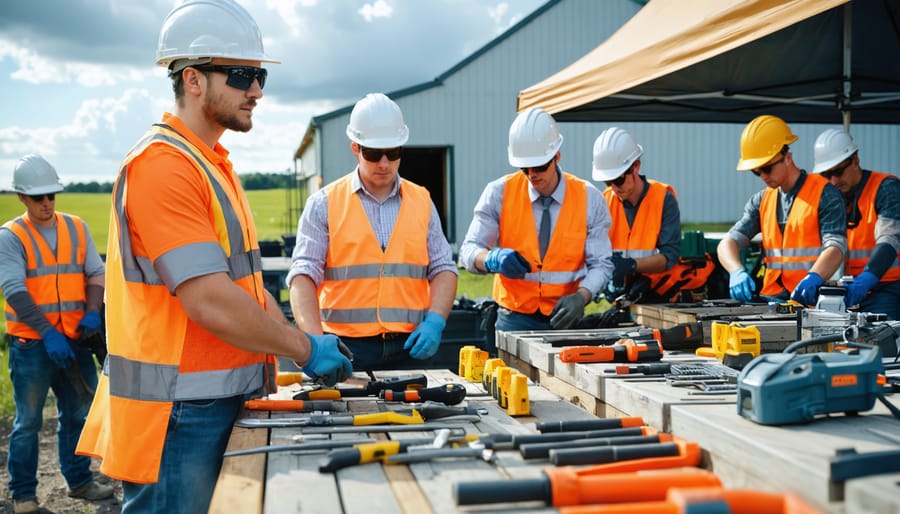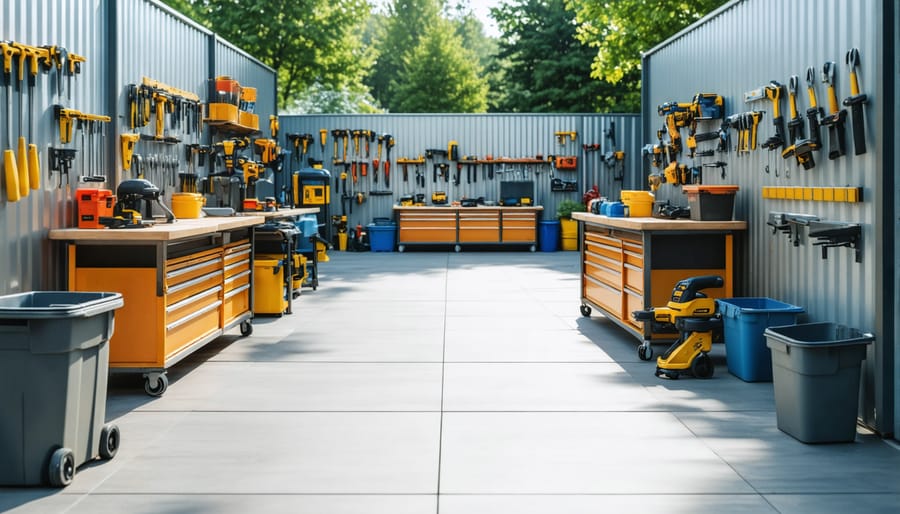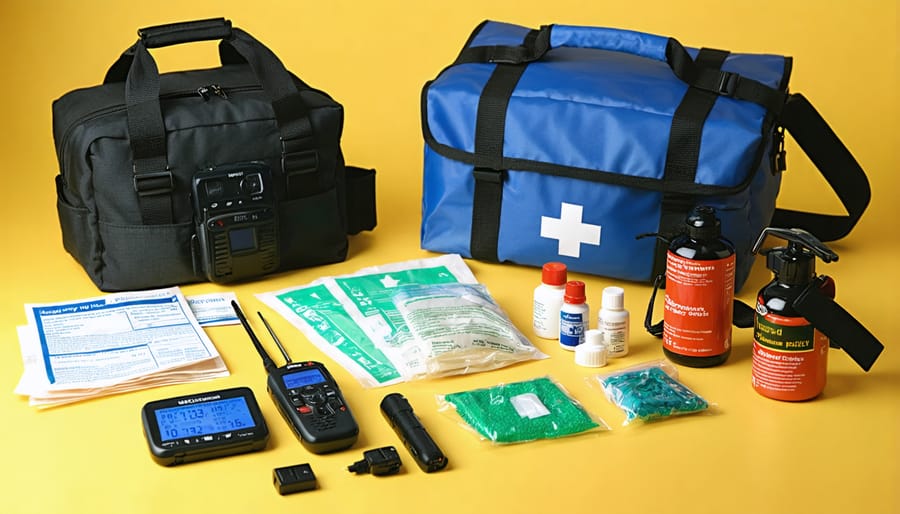Essential Outdoor Workspace Safety: Protect Your Team and Property

Establish clear weather response protocols and emergency evacuation routes before allowing any outdoor work activities. Post visible outdoor workspace safety guidelines at entry points, detailing procedures for extreme temperatures, lightning, and severe storms. Designate specific storage zones for hazardous materials, ensuring proper containment and clear labeling visible from all angles. Implement a mandatory equipment inspection schedule, focusing on weather-exposed tools and machinery that could pose increased risks in outdoor conditions.
Maintain designated walkways free from obstacles, with non-slip surfaces and adequate drainage to prevent weather-related hazards. Install proper lighting throughout outdoor work areas, particularly around storage units and equipment zones where visibility might be compromised during early morning or evening hours. Create clear communication channels for weather alerts and emergency notifications, ensuring every team member can quickly respond to changing conditions.
These foundational safety measures protect both personnel and property while maintaining operational efficiency in outdoor work environments.
Weather-Related Safety Measures
Lightning and Storm Protection
When storm clouds gather, take immediate action to ensure your safety. If you hear thunder, even from a distance, head indoors immediately – remember the “30-30 rule”: seek shelter if the time between lightning and thunder is less than 30 seconds, and stay inside for 30 minutes after the last thunder.
Avoid open areas and stay away from tall objects like trees, poles, or metal structures during electrical storms. If you’re caught outside with no immediate access to a building, a hard-topped vehicle is your next best option. Remove all metal objects, including jewelry and tools, and keep away from metal fencing or equipment.
During severe weather, monitor local weather reports and keep a weather radio handy. Have an emergency kit prepared with flashlights, batteries, and first-aid supplies. If high winds are expected, secure or store loose outdoor items that could become projectiles. Create and share an emergency plan with family members or coworkers, designating safe meeting spots and shelter areas.
Stay clear of windows and doors during intense storms, and unplug sensitive electronic equipment if possible. If flooding is a concern, move valuable items to higher ground and never attempt to drive through flooded areas.
Heat and Sun Exposure Guidelines
When working outdoors, implementing effective heat protection measures is crucial for your safety. Always check the weather forecast before starting outdoor activities and plan your work during cooler hours, typically early morning or late afternoon. Stay hydrated by drinking water regularly, even if you don’t feel thirsty, and take frequent breaks in shaded areas.
Protect yourself from harmful UV rays by wearing broad-spectrum sunscreen with at least SPF 30, reapplying every two hours or more frequently if sweating heavily. Don lightweight, loose-fitting clothing in light colors, and don’t forget a wide-brimmed hat and UV-protective sunglasses.
Watch for signs of heat-related illness, including dizziness, headache, or excessive sweating. If you experience any of these symptoms, move to a cool area immediately and seek help if needed. Set up temporary shade structures when working in direct sunlight, and keep a cooler with ice-cold water or sports drinks nearby. Remember, prevention is always better than dealing with heat exhaustion or sunburn after the fact.

Equipment and Tool Safety
Power Tool Safety
When working with power tools outdoors, safety should always be your top priority. Start by ensuring all electrical equipment is properly grounded and equipped with GFCI protection to prevent shock hazards. Keep your work area clean and free from debris that could interfere with tool operation or cause accidents.
Always wear appropriate personal protective equipment, including safety glasses, ear protection, and work gloves. Avoid loose clothing that could get caught in moving parts, and tie back long hair. Check weather conditions before starting work – never operate electrical tools in wet conditions or during storms.
Inspect your tools before each use, looking for damaged cords, loose parts, or signs of wear. Keep all guards and safety features in place, and never disable or modify them. Maintain a stable stance while working, and ensure your workspace is well-lit, even during daytime hours.
When you’re finished, unplug all tools and store them in a dry, secure location. Never carry tools by their cords or yank plugs from outlets. Keep children and pets away from your work area, and always use tools according to manufacturer instructions. Remember to take regular breaks to stay alert and focused while operating power equipment.
Storage and Maintenance
Proper storage of outdoor tools and equipment is crucial for maintaining a safe work environment. Invest in weather-resistant storage solutions to protect your tools from rust and deterioration, which can lead to dangerous malfunctions. Always clean tools before storing them, removing dirt, debris, and moisture that could compromise their integrity.
Create designated spaces for different types of equipment, using wall-mounted racks, pegboards, or sturdy shelving units to keep items organized and easily accessible. Store heavy items at waist level to prevent strain during retrieval, and keep sharp tools in protective sheaths or cases.
Regularly inspect stored equipment for signs of wear, damage, or pest infestation. Replace worn-out tools promptly, as damaged equipment poses significant safety risks. Keep chemicals in their original containers, properly labeled, and stored in a ventilated area away from direct sunlight and heat sources.
Maintain clear pathways in storage areas by removing trip hazards and ensuring adequate lighting. Consider installing motion-sensor lights for improved visibility during early morning or evening hours. Keep a maintenance log to track equipment inspections and repairs, ensuring all tools remain in safe working condition throughout the year.
Workspace Organization
Traffic Flow and Access
Maintaining clear paths and organized traffic flow in your outdoor workspace is essential for both efficiency and safety. Establish designated walkways at least three feet wide, keeping them free from tools, equipment, and other potential obstacles. Mark these pathways clearly with weather-resistant tape or paint to ensure they remain visible in all conditions.
Position frequently used items and equipment along these pathways for easy access while maintaining enough clearance for safe movement. Remember to keep emergency exits and access points completely unobstructed at all times. This includes ensuring that gates, doors, and emergency gathering points can be reached quickly without navigating around stored materials or equipment.
For vehicle access areas, create clearly marked zones for parking and loading. Install adequate lighting along all pathways and access points to ensure safe navigation during early morning or evening hours. Consider installing motion-sensor lights in less frequently used areas to improve visibility when needed.
Regularly inspect and maintain your traffic flow system, removing any accumulated debris, overgrown vegetation, or items that may have been temporarily placed in walkways. During seasonal changes, adjust your layout as needed to account for snow removal or drainage patterns.

Material Storage
Proper storage of materials and equipment is crucial for maintaining a safe outdoor workspace. Store all tools and equipment in a dedicated, weather-resistant shed or storage unit, keeping them organized and easily accessible. Implement a “first in, first out” system for materials like fertilizers, paints, and chemicals to prevent deterioration and ensure proper rotation.
Always store flammable materials in approved safety containers away from heat sources and direct sunlight. Keep chemicals in their original containers with legible labels, and never mix different substances. Place heavy items on lower shelves to prevent falling hazards and maintain proper weight distribution.
Create designated storage zones for different categories of materials, using clear labeling and signage. Install proper ventilation in storage areas to prevent the buildup of harmful fumes. Keep all storage areas clean, dry, and free from debris that could create tripping hazards or attract pests.
Lock up dangerous tools and materials when not in use, especially if children or unauthorized personnel might access the area. Regularly inspect storage containers and shelving for damage or wear, replacing them as needed to maintain safe storage conditions.
Emergency Preparedness
First Aid and Emergency Supplies
Keep a well-stocked first aid kit in your outdoor workspace, and ensure everyone knows its location. Essential supplies should include bandages, gauze, antiseptic wipes, adhesive tape, scissors, tweezers, and disposable gloves. Consider adding items specific to your environment, such as insect bite treatment or cold packs.
Store emergency contact numbers in a visible, weather-protected location. Include local emergency services, poison control, and the nearest medical facility. Keep a charged mobile phone nearby, and consider installing an emergency signal or alarm system for quick response during accidents.
Additional emergency supplies should include a fire extinguisher rated for multiple fire types, emergency blankets, and a flashlight with extra batteries. If your workspace is far from the main building, maintain a supply of drinking water and basic tools for emergency repairs.
Regularly check and replace expired items, and conduct periodic safety drills to ensure everyone knows the proper emergency procedures. Remember to keep all emergency supplies in waterproof containers and easily accessible locations.

Emergency Response Plans
In any outdoor emergency, quick thinking and preparedness are essential. Keep a well-stocked first aid kit easily accessible and ensure everyone knows its location. For weather-related emergencies, establish clear shelter points and evacuation routes. Create a communication chain with emergency contact numbers posted visibly, and designate meeting points for different scenarios.
If someone is injured, assess the situation calmly and call emergency services immediately if needed. For equipment-related accidents, shut down all power sources and secure the area before providing assistance. In case of fire, ensure everyone knows the location of fire extinguishers and how to use them properly.
Always keep a charged phone handy and consider installing an emergency alert system. Conduct regular drills to familiarize everyone with emergency procedures, and maintain an up-to-date list of emergency contacts including local authorities, medical facilities, and poison control. Remember to review and update your emergency response plans quarterly to ensure they remain current and effective.
Maintaining a safe outdoor workspace isn’t a one-time task – it’s an ongoing commitment to protecting yourself, your property, and others. By following these essential safety rules, you’ve taken important steps toward creating a secure environment for all your outdoor activities. Remember to regularly inspect your safety equipment, update emergency contact information, and review weather safety protocols with anyone who uses the space.
Make it a habit to conduct monthly safety checks of your outdoor area, paying special attention to seasonal changes that might affect safety conditions. Consider creating a simple checklist that you can reference throughout the year, and don’t hesitate to update your safety measures as new needs arise.
Sharing these safety guidelines with family members or employees ensures everyone understands their role in maintaining a secure environment. Together, you can create a culture of safety that becomes second nature. Remember, the most effective safety measures are the ones that are consistently practiced and regularly reviewed.
By staying vigilant and proactive about outdoor safety, you’re not just preventing accidents – you’re creating a more enjoyable and productive outdoor space for everyone to use.

